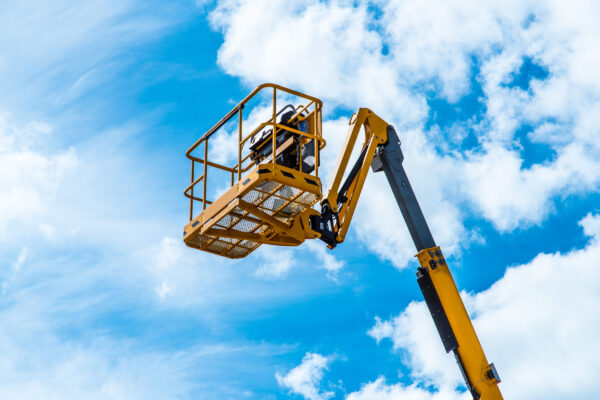The following guidelines have been established to reduce the risk of incident and personal injury when working with or in close proximity to bucket trucks (aka aerial lifts).
Aerial lift devices are used to elevate personnel to job sites above the ground. These include extendable boom platforms, aerial ladders, and aerial ladder trucks, articulating boom platforms, vertical towers and any combination of these devices. Aerial lift devices may be constructed of metal, wood, fiberglass, reinforced plastic or other materials.
Only properly trained and authorized employees are permitted to operate aerial lift devices. Employees have a responsibility to keep un-trained employees from entering and using the bucket and lift. Employees are responsible to wear all the required personal protective equipment.

Hazard Analysis
Whenever bucket trucks are operated in the vicinity of energized electrical utility lines the potential for electrocution exists. Even house drops and telephone circuits can be energized with enough voltage to kill. Lifts allow personnel to perform work above ground, creating a fall hazard. Operators must be aware of hazards including falls, tip-overs and electricity.
Fall Prevention and Personal Protective Equipment
Bucket trucks differ enough that even trained workers should not operate a bucket truck they are unfamiliar with on the job. Buckets or “baskets” are required to be at least 39” deep to put the lip above the waists of most workers and reduce the risk of falling out. Safety features such as guards, outrigger interlock and ground fault interrupter circuits, and warning labels are included on bucket trucks. These are designed to help prevent accidents and may not be modified or removed.
All employees are required to wear the personal protective equipment provided with each bucket truck operation:
- ANSI approved hardhat
- Eye protection
- Fall restraint system/Fall arrest system
- Insulated gloves where electrocution risk is possible
Bucket truck workers must wear a fall-restraint safety belt system or a full-body harness fall arrest system. Fall arrest equipment, work positioning equipment or travel restricting equipment shall be used by employees working at elevated locations more than 4 feet above the ground. When stopping or arresting a fall, personal fall arrest systems shall limit the maximum arresting force on an employee to 900 pounds if used with a body belt. When stopping or arresting a fall, personal fall arrest systems shall limit the maximum arresting force on an employee to 1800 pounds if used with a body harness.
Personal fall arrest systems shall be rigged such than at employee can neither free fall more than 6 feet nor contact any lower level. If vertical lifelines or drop lines are used, not more than one employee may be attached to any one lifeline.
Bucket Truck Preparation and Positioning Process
Fall-arrest/Fall-restraint equipment must be thoroughly inspected by a competent person before each use. Look for cuts, holes, tears, abrasions, frays, burns, chemical damage, and other signs of wear. Examine hardware to make sure it is in proper working order. Depending on how the truck is equipped, an inspection will be performed prior to each use:
Bucket Truck Inspection Checklist
|
|
|
Any problems found during an inspection must be corrected before a bucket truck is operated.
Bucket Truck Inspection Checklist
|
Any problems found during an inspection must be corrected before a bucket truck is operated.
Aerial Lift Walk Around Inspection
Before driving the bucket truck, perform a “walk around” inspection to make sure the boom is cradled and tied down and all other equipment is secure. Never move a bucket truck with the boom in an elevated position. The driver and all passengers will wear their seat belts.
Workers will survey the site prior to positioning the truck to perform work. Look for and avoid hazards that may set the stage for tip-over. The truck should have the emergency brake applied and wheels chocked. Outrigger pads may be necessary to assure firm footing. When extending or retracting outriggers verify that all workers are outside the danger zone. Follow signs and barricades rules for notifying traffic of work zone (located in company Safety & Health Manual).
Personnel should remove all climbers or “gaffs” or unnecessary metal objects that they might be wearing to minimize electrocution hazards. Fall-arrest/Fall-restraint equipment should be properly attached to anchor points supplied by the bucket truck manufacturer; belting off to other objects or structures is prohibited. The accompanying shock-absorbing lanyard is attached at the center of the wearer’s back, between the shoulder blades, fall-arrest system.
While performing work the employee should remain “boxed-in.” Stand firmly on the floor with both feet, not sitting or climbing on the bucket lip and never leaning out of the bucket. Do not use planks, ladders or other devices as substitute work positions. Do not move the aerial lift trucks with employees located in the elevated work boom position. Attending personnel may not operate lower controls unless permission has been obtained from the employee in the elevated platform except in the case of an emergency.
Bucket operators will take note of the location of co-workers on the ground prior to lowering the boom to avoid striking any employees working below.
Do not exceed the manufacturers load limits for boom or bucket load.
Emergency Response
If the work cannot be performed in an approved manner using the bucket truck, personnel must find another approach. If a worker becomes injured in the bucket or falls from the bucket and sustains injuries, call 911 immediately. Emergency numbers are posted in all bucket trucks. Then notify your supervisor. Report your location as specifically as possible.
Equipment and Fall-arrest Maintenance
Aerial lift devices may not be “field modified” for use other than those intended by the manufacturer. All modifications shall be pre-approved in writing by the manufacturer or by an equivalent authority, such as a nationally recognized testing laboratory, to be in conformity with ANSI/SIA A92.5-1992 requirements to be at least as safe as the equipment prior to modification.
Whenever a fall-arrest system prevents a fall, it must be examined by a competent person and certified sound before it is reused.
Whenever new equipment is acquired an initial inspection and test based on the manufacturer’s manuals will be performed. The company mechanic will also be responsible for periodic minor and major maintenance performed, and to check the manufacturer’s manual for each truck to determine maintenance requirements.
Facilitate Ongoing Safety and Usage Trainings
Training on bucket trucks for all employees will include manufacturer requirements, company rules, and government regulations in the curriculum. Training will occur every three years, sooner for observed unsafe work practices or if new employees are required to receive training as a condition of employment.
Training, Maintenance and Inspection Record Keeping
Human Resources and Outside Plant will retain initial employee training records of individuals authorized to operate specific aerial lift devices. Training curriculum will be stored with the Human Resources training file, while certifications will be filed in the employee’s personnel file.
Inspection records will be maintained by the operating employees and stored at the main office.
Vehicle and platform maintenance records will be maintained by the company Mechanic and kept with records at the main office.




